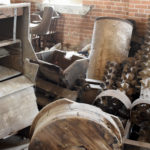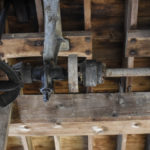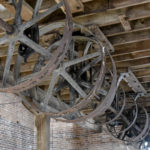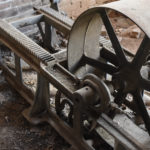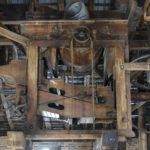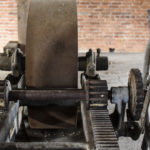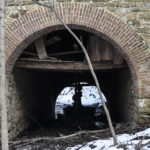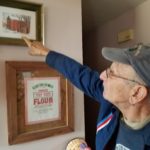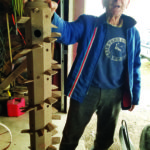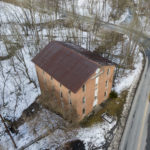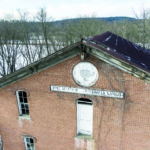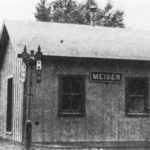Massive wooden hand-hewn beams highlight the historical significance and structural integrity of the Globe Mill, located along the banks of Middle Creek near the town of Kreamer in central Snyder County.
“It obviously took one heck of a big tree for each of those beams,” said 81-year-old John Eichman, the grandson of former mill owner J. Alvin Eichman. “And all of that work was done by hand, with axes. It’s amazing to think about.”
The mill hit its prime in the early 1900s as a flour mill that also did custom grinding of grain for local farmers, according to Eichman, who remembers working at the mill as a child.
“I was 12, maybe 13, and worked there with my dad and uncle, trying to keep the floors clean and doing any odd jobs they needed done,” he said. “The farmers would bring their grain to the front porch, and there was a rope going down and we’d put two bags on at a time and hoist them up to the third floor where it would be sorted into bins for grinding.
“There were six different machines that ground the wheat — the white part that came out was flour and the brown shell part would go into bran. They eventually got rid of those older machines and replaced it with one machine that did the work of all the others.”
The operation worked in conjunction with a nearby railroad station, called the Meiser station.
“They’d back the train cars down into a warehouse and we’d haul the bags from there up to the mill,” Eichman said. The operation took off, and according to John’s wife, June, “it was the largest-producing flour mill in the United States — maybe the whole world — at the time.”
The earliest records of the mill date back to 1778 when a frame grist mill was erected on the south stretch of Middle Creek. In 1871, the Sunbury and Lewistown Railroad Company laid track along the south side of the mill property, then owned by Samuel H. Yoder. He replaced the mill in 1885 with the current three-bay by four-bay, 3.5-story brick structure on a stone foundation that can still be seen today.
The mill was later bought by J. Alvin Eichman.
“He came over directly from Germany and bought the mill right around when he got married,” June said. “John’s uncle (Lear) was born in 1900 and father (Mark) in 1903.”
The mill was powered by Middle Creek, as water flowed through two horizontally laid turbine wheels.
“They were like a jet motor with fins all the way around,” said John. “There was a big wheel upstairs, and if you wanted more power, you’d open up the fins. That would run the elevators and augers. Elevators would take grain to the third floor and drop into the machines. It was quite an operation.”
The mill used to have a large sign on the front that John remembers painting.
“I helped take it down and painted it, but then it laid there for a couple years,” he said. “My dad and I were talking about it one day, and my grandma told us she’d like to see it back up.”
“And what she said, they did,” June interrupted with a laugh.
The mill closed in the mid-1950s, according to John, and was eventually sold to a woman named Helen, who used the building to raise chinchillas under the name Pine Meadow Chinchilla Ranch.
“She changed a lot, including many of the windows,” he said.
“They had 1,000s of chinchillas in there. I guess they sold the hides,” added June. “But rumor has it that the guy she was with left, and the chinchillas, I don’t know, I guess they froze to death.”
Guy Graybill, a local historian, toured the mill a number of decades ago before the chinchilla operation.
“I remember seeing some of the materials in there quite a few years ago before the chinchillas were turned loose,” he said. “I don’t think the people with chinchillas got to things to the point they expected. I remember when they were in there, but I don’t know who they were. They weren’t natives of area.”
More recently, the mill was purchased by Christ Yoder, a truck driver who lives two houses down from the facility. He is still considering what to do with the property.
“Words can’t describe how it makes me feel to own a piece of history like that,” he said.


